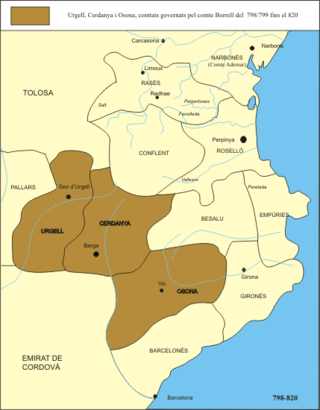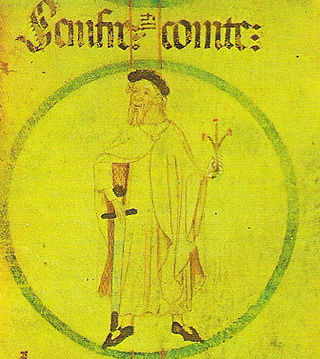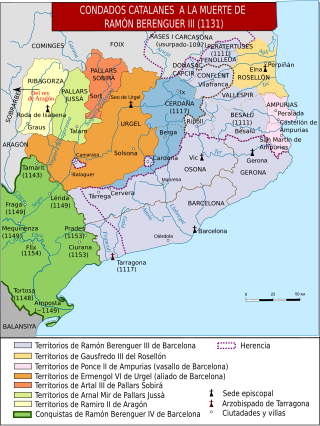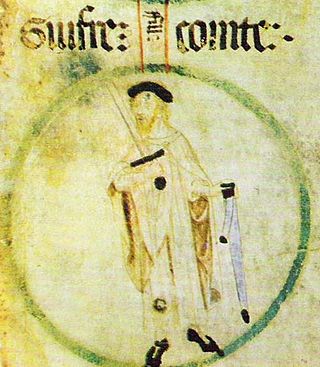History
Borrell was the son of Sunyer. In 967 he married Letgarda, who is speculated to have been daughter of a Count of Toulouse or Rouergue based on the names given to her children. By her Borrell had two sons and two daughters: Ramon Borrell (972–1017), Ermengol (974–1010), Ermengarda and Richilda. After Letgarda's death circa 986, he married Eimeruda, perhaps of Auvergne in 987.
Borrell's military career seems to have been undistinguished—he is recorded as fighting only two battles and seems to have lost both—and it was under his rule that Barcelona was sacked in 985 by the Muslim leader Almanzor. [3] [4] On the other hand, he had far greater success as a diplomat. Before the attacks of the 980s, and discounting a single raid by the Caliph al-Hakam II soon after his succession in 961, he maintained cordial relations with the Muslim rulers of Córdoba and also sent emissaries to the kings of the Franks. [5] Furthermore, in 970, he voyaged to Rome to meet with both Pope John XIII and Emperor Otto I. [6]
Borrell was also a patron of learning and culture. In 967, Borrell visited the monastery of Aurillac and the Abbot asked the count to take Gerbert of Aurillac (the future Pope Sylvester II) with him so that the boy could study mathematics in Spain. In the following years, Gerbert studied under the direction of Bishop Atto of Vic, some 60 km north of Barcelona, and probably also at the nearby monastery of Santa Maria de Ripoll. [7] He was also taken on the 970 embassy to Rome, during which the Pope persuaded Otto to employ Gerbert as a tutor for his young son, the future emperor Otto II.
In 985 the Hispanic March was attacked by the Muslim general Almanzor, who managed to take Barcelona, which was pillaged and sacked. Many citizens were taken prisoner by the Muslim forces. [8] Borrell sent a request for help to King Lothar III, the current King of the Western Franks, [9] but although documents of Borrell's refer to royal orders that must have come from this embassy, [10] actual military assistance was beyond Lothar's power. What appears to have been a similar plea to Hugh Capet resulted in a letter from Hugh to Borrell promising aid if the count preferred "to obey us rather than the Ishmaelites", [11] but in any event Hugh could not persuade his nobles to support a southern expedition. [12] No answer to Hugh's letter is known from Borrell, and the connection between the March and France was effectively broken. Nationalist Catalan historians consider this the point at which "Catalonia" became a sovereign power, and the millennium of their independence was celebrated in 1987 with conferences and numerous publications; but it appears that other "Catalan" counties, other than Borrell's, retained links with the Frankish crown for a little longer. [13]
From 988, Borrell's sons Ramon Borrell and Ermengol appear as rulers in a divided territory, with Ramon Borrell being count of Barcelona, Girona, and Osona and Ermengol being count of Urgell. [14] Borrell II continued to issue documents and tour his domains, however, and when he was taken ill in 993 in Castellciutat near la Seu d'Urgell, the will that he made provided for him outliving his executors. [15] It was not to be, however, and his death followed soon afterwards. [16]

The County of Urgell is one of the historical Catalan counties, bordering on the counties of Pallars and Cerdanya.

The County of Osona, also Ausona, was one of the Catalan counties of the Marca Hispanica in the Early and High Middle Ages. It was based around the capital city of Vic (Vicus) and the corresponding diocese, whose territory was roughly the current comarca of Osona.

The Diocese of Urgell is a Latin Church diocese of the Catholic Church in Catalonia (Spain) and Andorra in the historical County of Urgell, with origins in the fifth century AD or possibly earlier. It is based in the region of the historical Catalan County of Urgell, though it has different borders. The seat and Cathedral of the bishop are situated in la Seu d'Urgell town. The state of Andorra is a part of this diocese.

The Principality of Catalonia was a medieval and early modern state in the northeastern Iberian Peninsula. During most of its history it was in dynastic union with the Kingdom of Aragon, constituting together the Crown of Aragon. Between the 13th and the 18th centuries, it was bordered by the Kingdom of Aragon to the west, the Kingdom of Valencia to the south, the Kingdom of France and the feudal lordship of Andorra to the north and by the Mediterranean Sea to the east. The term Principality of Catalonia was official until the 1830s, when the Spanish government implemented the centralized provincial division, but remained in popular and informal contexts. Today, the term Principat (Principality) is used primarily to refer to the autonomous community of Catalonia in Spain, as distinct from the other Catalan Countries, and usually including the historical region of Roussillon in Southern France.

Sunifred was the Count of Urgell and Cerdanya from 834 to 848, and the Count of Barcelona as well as many other Catalan and Septimanian counties, including Ausona, Besalú, Girona, Narbonne, Agde, Béziers, Lodève, Melgueil, Conflent and Nîmes, from 844 to 848.

Ramon Borrell was count of Barcelona, Girona and Ausona from 992. He was the son of Borrell II of Barcelona and Letgarda of Rouergue, and was associated with his father in ruling the counties from 988.

Sunyer was count of Barcelona, Girona and Ausona from 911 to 947.

The County of Barcelona was a polity in northeastern Iberian Peninsula, originally located in the southern frontier region of the Carolingian Empire. In the 10th century, the Counts of Barcelona progressively achieved independence from Frankish rule, becoming hereditary rulers in constant warfare with the Islamic Caliphate of Córdoba and its successor states. The counts, through marriage, alliances and treaties, acquired or vassalized the other Catalan counties and extended their influence over Occitania. In 1164, the County of Barcelona entered a personal union with the Kingdom of Aragon. Thenceforward, the history of the county is subsumed within that of the Crown of Aragon, but the city of Barcelona remained preeminent within it.

The Catalan counties were the administrative Christian divisions of the eastern Carolingian Hispanic Marches and the southernmost part of the March of Gothia in the Pyrenees created after their rapid conquest by the Franks.
The County of Cerdanya was one of the Catalan counties formed in the last decades of the 8th century by the Franks in the Marca Hispanica. The original Cerdanya consisted of the valley of the upper Segre. Today Cerdanya is a Catalan comarca.

Ermengol or Armengol VI, called el de Castilla, was the Count of Urgell from 1102 until his death. He was the son and successor of Ermengol V and María Pérez, daughter of Count Pedro Ansúrez, Lord of Valladolid, who became the young Ermengol's tutor when he was orphaned in 1102.

Ermengol or Armengol II, called the Pilgrim, was the Count of Urgell from 1011 to his death. He was the son of Ermengol I, Count of Urgell and his second wife, Guisla. Still a child when he succeeded his father, who was killed in battle against the Moors, he was put under the regency of his uncle Ramon Borrell, Count of Barcelona until 1018.
Ermengol or Armengol I (974–1010), called el de Córdoba, was the Count of Urgell from 992 to his death. He was the second son of Borrell II of Barcelona and his first wife, Letgarda. He was the second of the counts of Urgell and famous mainly for his participation in the Reconquista.
The Battle of Albesa was a follow-up to the Battle of Torà that took place 25 February 1003 at Al-Qaṣr al-Māša (Albesa), near Balagî (Balaguer), between the united Christian forces of the Catalan counties and the Islamic forces of the Caliphate of Córdoba. It was one of the border skirmishes associated with the interminable razzias of the Reconquista, described as "a simple encounter between local forces" and "a local action without overarching importance", though both these views are called into question by the assemblage of important Catalan nobles at the battle and the Muslim reprisal which followed.
Sal·la was the Bishop of Urgell from 981 to 1010, and "one of the first Catalan figures whose own words" survive sufficiently "to give colour to his personality and actions", although all of the words attributed to him were written down by scribes. He receives mention in some sixty-three surviving contemporary documents. As bishop, Sal·la dated documents by the reign of Hugh the Great. Although his episcopate largely preceded the Peace of God movement in Catalonia, his excommunication of high-ranking public figures during a church–state dispute in 991 anticipated it. He also pioneered feudal practices such as the granting of fiefs and was frequently "ahead of the feudalising wave".
Wilfred or Wifred, called the Hairy, was Count of Urgell, Cerdanya, Barcelona, Girona, Besalú and Ausona. On his death in 897, his son, Wilfred Borrell, inherited these counties, known by the historiography as the Catalan counties.

Wilfred II or Wifred II, also known as Borrell I or Borrel I, was Count of Barcelona, Girona, and Ausona from 897 to 911, succeeding his father, Wilfred I the Hairy. His mother was Guinedilda.

The House of Montcada is an aristocratic and noble Spanish Catalan House with important ramifications in Sicily. Queen Elisenda of the Crown of Aragon was a member of the family.

The Raid of 897 was a military campaign of the Emirate of Cordoba against the County of Barcelona.
The Battle of Mollerussa took place in the south of the county of Urgell on 11 or 14 September 1102. In the battle, Count Ermengol V was defeated and killed by an Almoravid army. Mollerussa lies halfway between Bellpuig and Lleida and is the largest town in the Pla d'Urgell.














